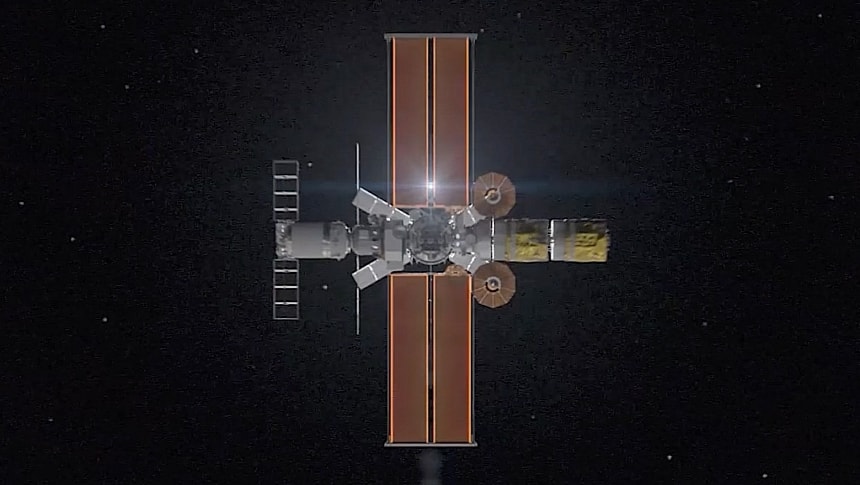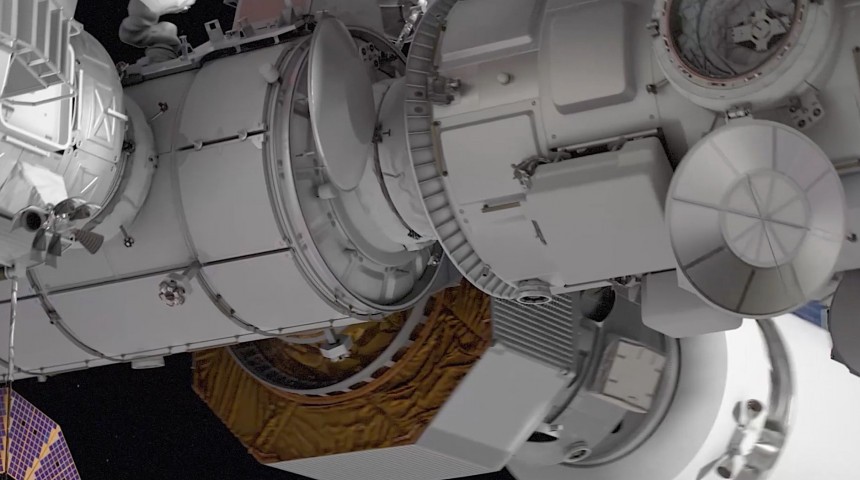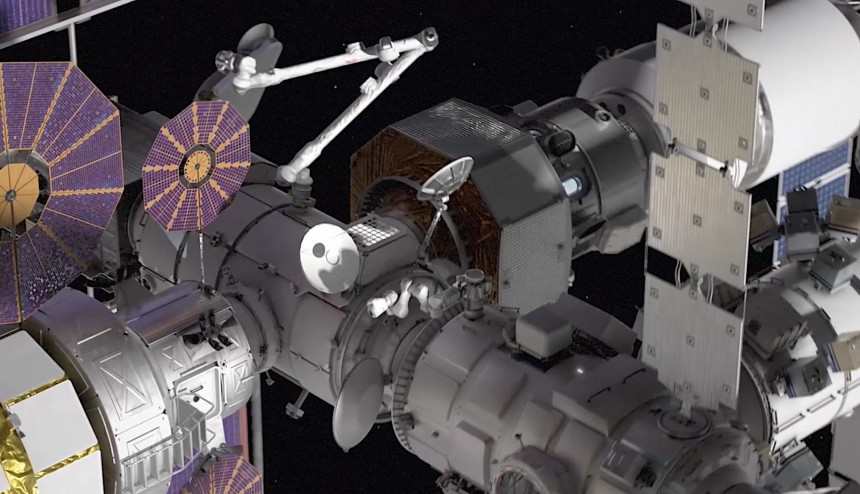Soon enough, humanity will place a new space station in, well, space. It will be our species' third operational one, after the International Space Station (ISS) and the Tiangong Space Station (TSS), but the first one that will not orbit Earth, but another celestial body: the Moon.
Tracing its roots to 2012, where plans for a station called Deep Space Habitat were first drafted, the Gateway, as the construction has been called since 2018, will become an important part of the Artemis Moon exploration program, and it will also be a stepping stone for crewed missions to Mars.
Because of the size of the project, the Gateway (full name Lunar Orbital Platform-Gateway) is a collaborative effort between both state and private actors, based in North America, Japan, and Europe. The world's major space agencies, NASA, CSA, JAXA, ESA, will work with private contractors, including SpaceX, Maxar, or Northrop Grumman, to put together something that will probably become humanity's most daring engineering project ever.
A lot of things about the station are already known. It will comprise, for instance, three main elements: the Power and Propulsion Element (PPE), the Habitation and Logistics Outpost (HALO), and the Lunar International Habitat (Lunar I-HAB).
PPE is where the station will get its power from, but also its means of moving around in lunar orbit. Technically a hub for harnessing solar energy and using it to power the Gateway's systems, it will also ionize xenon to generate thrust. By all intents and purposes, the Maxar-made PPE will make the Gateway "the most powerful solar electric spacecraft ever flown."
HALO is essentially the station's nerve center, the place from where comms, both to the surface of the Moon and to Earth, will be made possible. It's also where the Gateway's command and control, life support system, and science payload banks are located. The module is being put together by Northrop Grumman.
Last but not least comes ESA's Lunar I-Hab, the place where astronauts will live and work. It, too, houses life support systems.
All these main elements, along with others, have been depicted before in various forms, but never in a manner so detailed as the one NASA showed us this week. Through a rather short video (under two minutes), we're taken on a trip to admire the exterior of the space station in such detail it will probably make you dizzy – the spinning effect of the station probably contributes to that as well.
Aside from the three main modules mentioned above, the video also shows the Crew and Science Airlock. That's the door that will allow crew and hardware to be transferred from and into the station. This part of the station is the work of the Mohammad Bin Rashid Space Centre from the United Arab Emirates.
The Canadian Canadarm3 robotic arm is visible as well, as is the Artemis program Orion spacecraft, docked to the airlock mentioned above. If you look carefully enough, you'll also see the Human Landing System (HLS), the spacecraft that will ferry astronauts to the surface of the Moon and back. In real life, there will be two of them, the Starship made by SpaceX and the Blue Moon produced by Blue Origin.
There are also some payloads visible in the video. Among them there are the European Radiation Sensors Array (ERSA, attached to the PPE), the Heliophysics Environmental and Radiation Measurement Experiment Suite (HERMES, attached to HALO), and even the Internal Dosimeter Array (IDA, inside HALO).
Construction of the Gateway space station will begin in 2025 with the launch of the PPE and HALO, both of them departing our planet on board a SpaceX Falcon Heavy rocket. The two modules will launched connected to one another and will spend about a year en route to the Moon, simply because they'll travel solely on power supplied by solar-electric propulsion and the gravity of the Earth.
The station will take up an oval orbit that will take it over both of the satellites' poles, because this one was deemed the best to allow descending parties to easily reach their destination on the surface, but also because such an orbit facilitates unique views of the Earth and the Sun, and at the same time allows for future studies of deep space to be conducted.
Come 2028, the I-Hab will launch as well, on the same flight with the astronauts of the Artemis IV mission, powered by the Space Launch System (SLS) rocket in Block 1B configuration. The four people on the mission will become the first-ever occupants of the space station, the ones that will bring the Gateway online for the first time and get the hardware and software on board ready for surface operations.
The first mission to the Moon will depart Gateway shortly after, using the SpaceX landing system.
Because of the size of the project, the Gateway (full name Lunar Orbital Platform-Gateway) is a collaborative effort between both state and private actors, based in North America, Japan, and Europe. The world's major space agencies, NASA, CSA, JAXA, ESA, will work with private contractors, including SpaceX, Maxar, or Northrop Grumman, to put together something that will probably become humanity's most daring engineering project ever.
A lot of things about the station are already known. It will comprise, for instance, three main elements: the Power and Propulsion Element (PPE), the Habitation and Logistics Outpost (HALO), and the Lunar International Habitat (Lunar I-HAB).
PPE is where the station will get its power from, but also its means of moving around in lunar orbit. Technically a hub for harnessing solar energy and using it to power the Gateway's systems, it will also ionize xenon to generate thrust. By all intents and purposes, the Maxar-made PPE will make the Gateway "the most powerful solar electric spacecraft ever flown."
HALO is essentially the station's nerve center, the place from where comms, both to the surface of the Moon and to Earth, will be made possible. It's also where the Gateway's command and control, life support system, and science payload banks are located. The module is being put together by Northrop Grumman.
All these main elements, along with others, have been depicted before in various forms, but never in a manner so detailed as the one NASA showed us this week. Through a rather short video (under two minutes), we're taken on a trip to admire the exterior of the space station in such detail it will probably make you dizzy – the spinning effect of the station probably contributes to that as well.
Aside from the three main modules mentioned above, the video also shows the Crew and Science Airlock. That's the door that will allow crew and hardware to be transferred from and into the station. This part of the station is the work of the Mohammad Bin Rashid Space Centre from the United Arab Emirates.
The Canadian Canadarm3 robotic arm is visible as well, as is the Artemis program Orion spacecraft, docked to the airlock mentioned above. If you look carefully enough, you'll also see the Human Landing System (HLS), the spacecraft that will ferry astronauts to the surface of the Moon and back. In real life, there will be two of them, the Starship made by SpaceX and the Blue Moon produced by Blue Origin.
There are also some payloads visible in the video. Among them there are the European Radiation Sensors Array (ERSA, attached to the PPE), the Heliophysics Environmental and Radiation Measurement Experiment Suite (HERMES, attached to HALO), and even the Internal Dosimeter Array (IDA, inside HALO).
Construction of the Gateway space station will begin in 2025 with the launch of the PPE and HALO, both of them departing our planet on board a SpaceX Falcon Heavy rocket. The two modules will launched connected to one another and will spend about a year en route to the Moon, simply because they'll travel solely on power supplied by solar-electric propulsion and the gravity of the Earth.
Come 2028, the I-Hab will launch as well, on the same flight with the astronauts of the Artemis IV mission, powered by the Space Launch System (SLS) rocket in Block 1B configuration. The four people on the mission will become the first-ever occupants of the space station, the ones that will bring the Gateway online for the first time and get the hardware and software on board ready for surface operations.
The first mission to the Moon will depart Gateway shortly after, using the SpaceX landing system.














